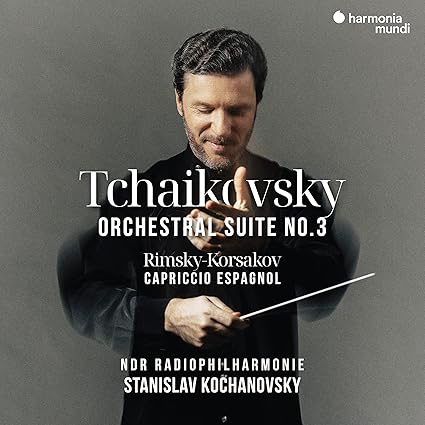Not only is this Kochanovsky’s debut on record, it’s also the NDR Radiophilharmonie’s debut on the harmonia mundi label. And while I have heard this orchestra before on CPO and Pentatone, I’ve never heard them sound like this.
So this disc is worth hearing for the beautiful recorded sound, but it really would all be for naught if the performances weren’t equally good. And are they ever. (Well, mostly.) Not only musically from the podium, but the orchestral playing itself. This is not your every-day, anonymous, efficient sound so often heard from too many orchestras today; one can instantly hear that this orchestra adores their new conductor. For example, just listen to the vibrancy in their soft playing, which is stunning. It’s not impassive or just soft to be soft – it’s alive! (And, yes, it’s definitely soft too.) And I would be remiss in not pointing out, specifically, how fabulous the strings of this orchestra are – their fervent singing lines potent with ardor. And I’m not sure if it’s the hall or the mastery of the engineer (or both), but it sounds like there are hundreds of violins soaring heavenward. This string section actually reminds me of Domingo Hindoyan’s Royal Liverpool Philharmonic strings, who sing just as rapturously under his direction. I dwell on this because it is so rare to hear – not only from the orchestral playing, but from the recorded sound as produced on a good stereo system. And I might point out that this isn’t even SACD; this is good old fashioned CD – proving once again the medium is alive and well, and when done right, can still produce some of the finest recorded sound of a symphony orchestra.
The opening piece by Tcherepnin (the daddy, Nikolai, who was a pupil of Rimsky-Korsakov) is a glorious thing, and makes a wonderful concert opener. It was written in 1899 as a prelude to a play, and sounds a lot like Tchaikovsky – a bit less passionate, but possessing rhapsodic melodies throughout. And it’s here where Kochanovsky’s strings first make a strong impression there in the central section – those melodic lines singing with an almost operatic fervor, building to an overwhelming climax. I was so moved, I could easily imagine Marilyn Horn singing it. And the magnificent recording, with its glorious portrayal of an airy, spacious acoustic, surrounding the strings with air, even in the midrange, presents the orchestra with a palpable realism – transporting the listener to the best seat in the house.
This Prelude has been recorded before, most notably by Pletnev and the Russian National Orchestra on a 1994 DG album entitled “The Enchanted Kingdom”. Harmonia mundi’s alluring sound is even more colorful and atmospheric than DG’s, allowing Kochanovsky to make an even more memorable and convincing case for it.
I was pleased to see Tchaikovsky’s Third Suite on this program. It’s quite challenging, and was rather daring of Kochanovsky to start off with this one. (And I do hope he intends to record the other 3 as well.) Even though the 4th movement Theme and Variations is often performed independently, that’s the least interesting bit for me. I absolutely adore the opening Elegie, and never more so than here in Kochanovsky’s hands, as he immerses us in the glories of one of Tchaikovsky’s most achingly heartfelt and beautiful Andante cantabiles. Cantabile for sure, but with a natural, free-flowing tempo, Kochanovsky luxuriates in the rhapsodic melodies, lush harmonies, and radiant orchestration. And the orchestra plays their hearts out for him, just as they did before in the Tcherepnin.
The tempo is perfectly judged in the Valse too, which moves along with enough forward momentum to make it danceable, while fully illuminating the melancolique indication. And that presto Scherzo which follows is tricky – not only in the extremely demanding woodwind writing (all that triple-tonguing!), but its rhythmic intricacy is very difficult to come together without sounding clunky or clumsy. All those fast repeated notes passed around from section to section, measure by measure, must be handed off seamlessly and gracefully without the slightest hesitation or change in volume. It’s extremely difficult to bring off. And to be fair, the NDR Radiophilharmonie isn’t quite perfect or as effortless as the very best version ever recorded – that unbelievable, incredibly thrilling one from Vladimir Jurowski and the Russian National Orchestra on Pentatone (2006) – or Jarvi in Detroit (1995 Chandos), who comes very close to it. But this is very well executed with a sense of spontaneity as if in a live concert.
Kochanovsky does the final Theme and Variations as well as anyone, generating plenty of drama and momentum as it goes – culminating in a triumphant conclusion aided by majestic recorded sound. Yes, it could be a bit more dynamic and enthusiastic, but musically this is very satisfying.
My admiration for this conductor was tempered somewhat by the coupling. Sandwiched in the middle there is the ubiquitous Capriccio espagnol – which isn’t exactly a great fit with the impassioned music on either side of it. But I understand why it’s there – to entice collectors into buying this CD. (Even the marketing blurb on the back cover touts it first and foremost.) Few will be drawn to a disc of Tchaikovsky’s 3rd Suite and relatively unknown Tcherepnin. So if the Rimsky-Korsakov helps generate some sales, then I’m all for it. However, I admit I wasn’t at all in the mood for it (especially after listening to the wonderful Tchaikovsky). So I saved it for later and came back to another day, hoping Kochanovsky would knock my socks off with it.
(He didn’t.)
In fact, it’s rather leisurely and surprisingly low-key, almost as if Kochanovsky was trying to tone down its exuberance to better match the music on either side of it. Even the brass fanfares and the solo passages there in the central section (violin, flute, clarinet) are played with “feeling” rather than flair (yawn.) And thereafter, there isn’t much verve or panache. Even the final rush to the finish isn’t much of a rush; it’s “let’s just get this over with” in its efficiency. Whatever the reason, it was perhaps ill-advised, as anyone buying this disc primarily for Capriccio Espagnol will likely be disappointed with it – and consequently, with this conductor.
So Kochanovsky isn’t fantastic at everything; and that’s OK. He may not be the most exciting conductor to appear, but the rest of his program is so good, the Rimsky doesn’t really matter. I mean, realistically, who needs (or even wants) another Capriccio Espagnol? I just wish he had chosen something else instead – something more appropriate for the program and better suited to his temperament. Tchaikovsky’s 4th Orchestral Suite comes immediately to mind, which would have just fit on the CD without the Rimsky-Korsakov there, and would have been infinitely more rewarding and complementary.
Nonetheless, this is a splendid disc – gorgeously played and recorded. I don’t think I’ve ever been more impressed with a recording from this label.





